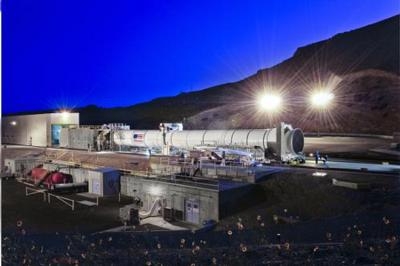Fri, Aug 08, 2014
NASA And ATK Say They Are On Schedule For 2017 Launch
ATK has successfully completed its Critical Design Review (CDR) with NASA to verify that the five-segment solid rocket booster is on track for an unmanned, first flight of NASA's Space Launch System (SLS) in 2017. The SLS vehicle is planned to launch humans deeper into space than ever before.

"Achieving this milestone is a tremendous accomplishment for ATK and NASA as we continue building the boosters for America's Space Launch System," said Charlie Precourt, vice president and general manager of ATK's Space Launch division. "Deep space exploration requires a heavy lift vehicle, and SLS is the only vehicle with the mass, volume and speed required for human missions to destinations such as the moon, an asteroid or Mars."
With the successful completion of CDR, the SLS booster design can now proceed toward qualification testing. Booster avionics qualification efforts are also in work and will be incorporated into the vehicle qualification effort that is scheduled for completion in 2016.
"ATK's technology innovation, process improvements and lean manufacturing will enable SLS to deliver humans and cargo to deep space faster, safer and more affordably than any other existing or planned vehicle," said Precourt, who is also a four-time space shuttle astronaut. "It is exciting to see that the teams working on SLS and the Orion crew capsule are all making steady progress toward NASA achieving a human mission to Mars by the 2030s."
A ground static firing of the full-scale booster, Qualification Motor-1 (QM-1), is planned for late this year/early next year at ATK's facility in Promontory, Utah. The next major booster milestone will be the Design Certification Review scheduled for fall of 2016.
Other upcoming SLS and Orion program milestones include a firing of the modified RS-25 engine this fall and the opening of the SLS Vertical Assembly Center, which is where the rocket's core stage fuel tanks will be welded. Orion's first flight, scheduled for December 2014, will be the farthest a human-rated spacecraft has traveled into space in more than 40 years.
(Image provided by ATK)
More News
Pilot Applied Full Aft Stick And Nose-Up Trim, But The Airplane Remained On The Runway Analysis: The pilot reported that a preflight inspection and flight control checks revealed n>[...]
A Few Questions AND Answers To Help You Get MORE Out of ANN! 1) I forgot my password. How do I find it? 1) Easy... click here and give us your e-mail address--we'll send it to you >[...]
From 2022 (YouTube Edition): Before They’re All Gone... Humankind has been messing about in airplanes for almost 120-years. In that time, thousands of aircraft representing i>[...]
Advanced Air Mobility (AAM) A transportation system that transports people and property by air between two points in the NAS using aircraft with advanced technologies, including el>[...]
Aero Linx: MQ-1B Predator The MQ-1B Predator is an armed, multi-mission, medium-altitude, long-endurance remotely piloted aircraft that is employed primarily as an intelligence-col>[...]
 NTSB Final Report: Douglas A-4K
NTSB Final Report: Douglas A-4K ANN FAQ: Q&A 101
ANN FAQ: Q&A 101 Classic Aero-TV: PBY Catalina--From Wartime to Double Sunrise to the Long Sunset
Classic Aero-TV: PBY Catalina--From Wartime to Double Sunrise to the Long Sunset ANN's Daily Aero-Term (07.01.25): Advanced Air Mobility (AAM)
ANN's Daily Aero-Term (07.01.25): Advanced Air Mobility (AAM) ANN's Daily Aero-Linx (07.01.25)
ANN's Daily Aero-Linx (07.01.25)



